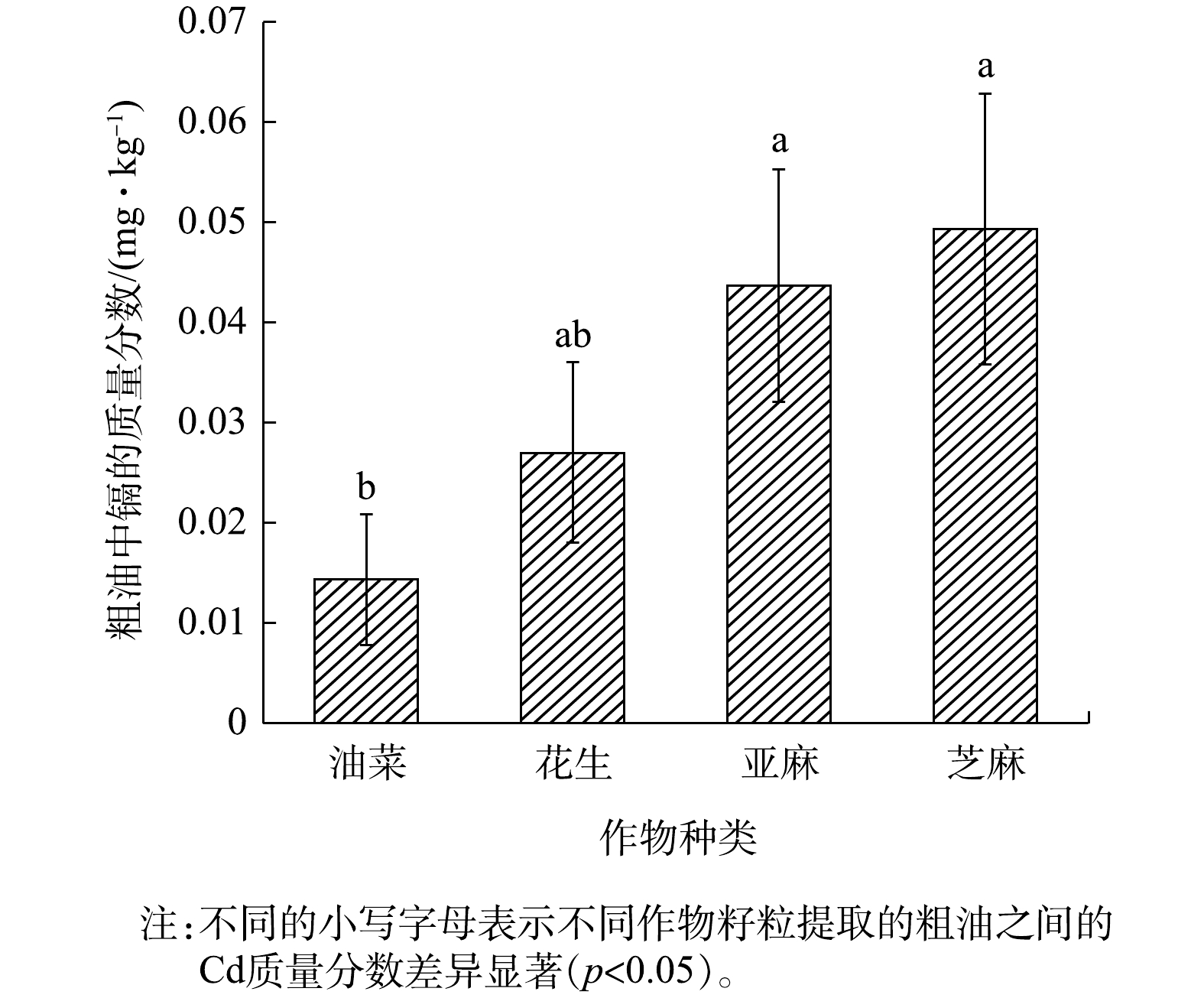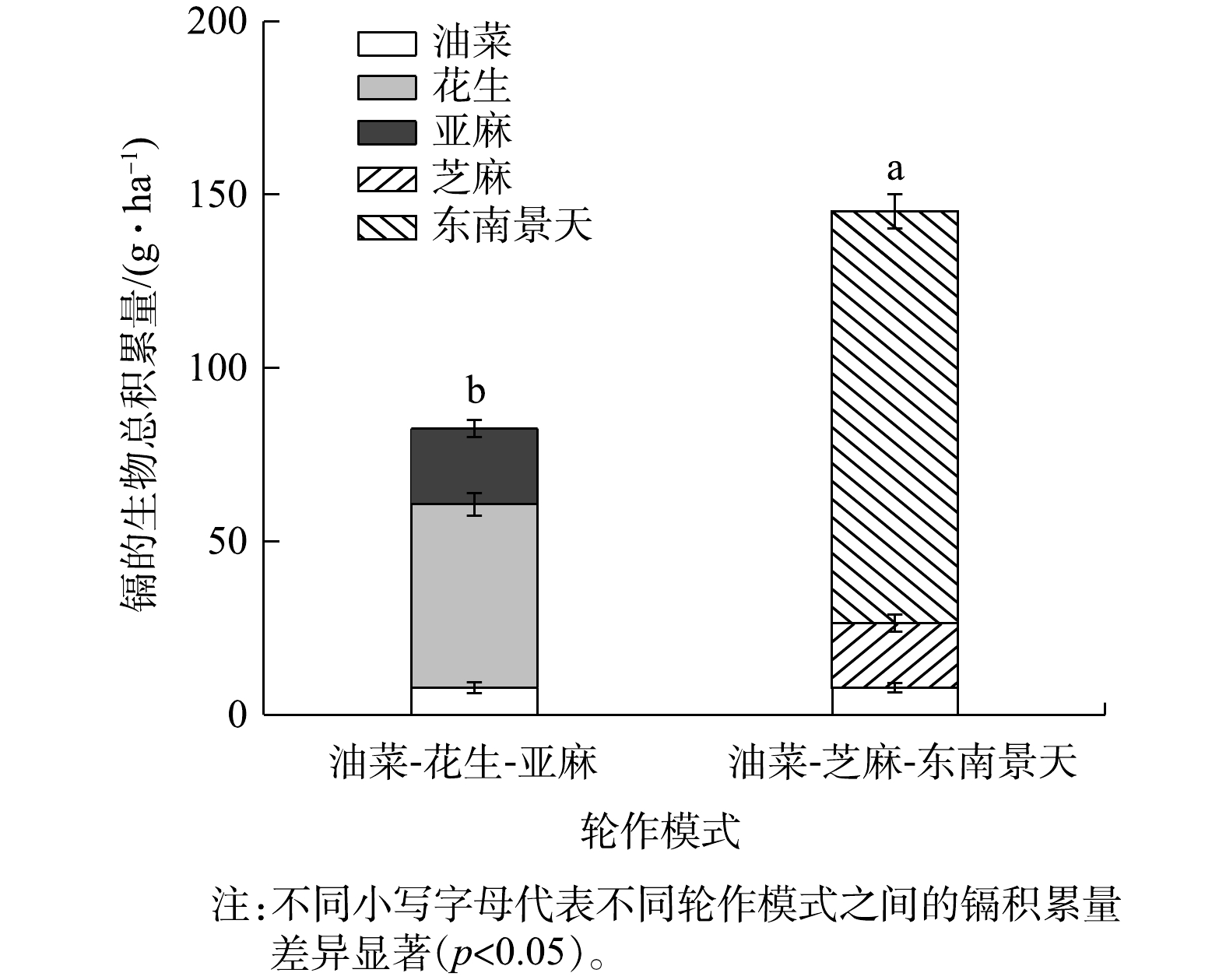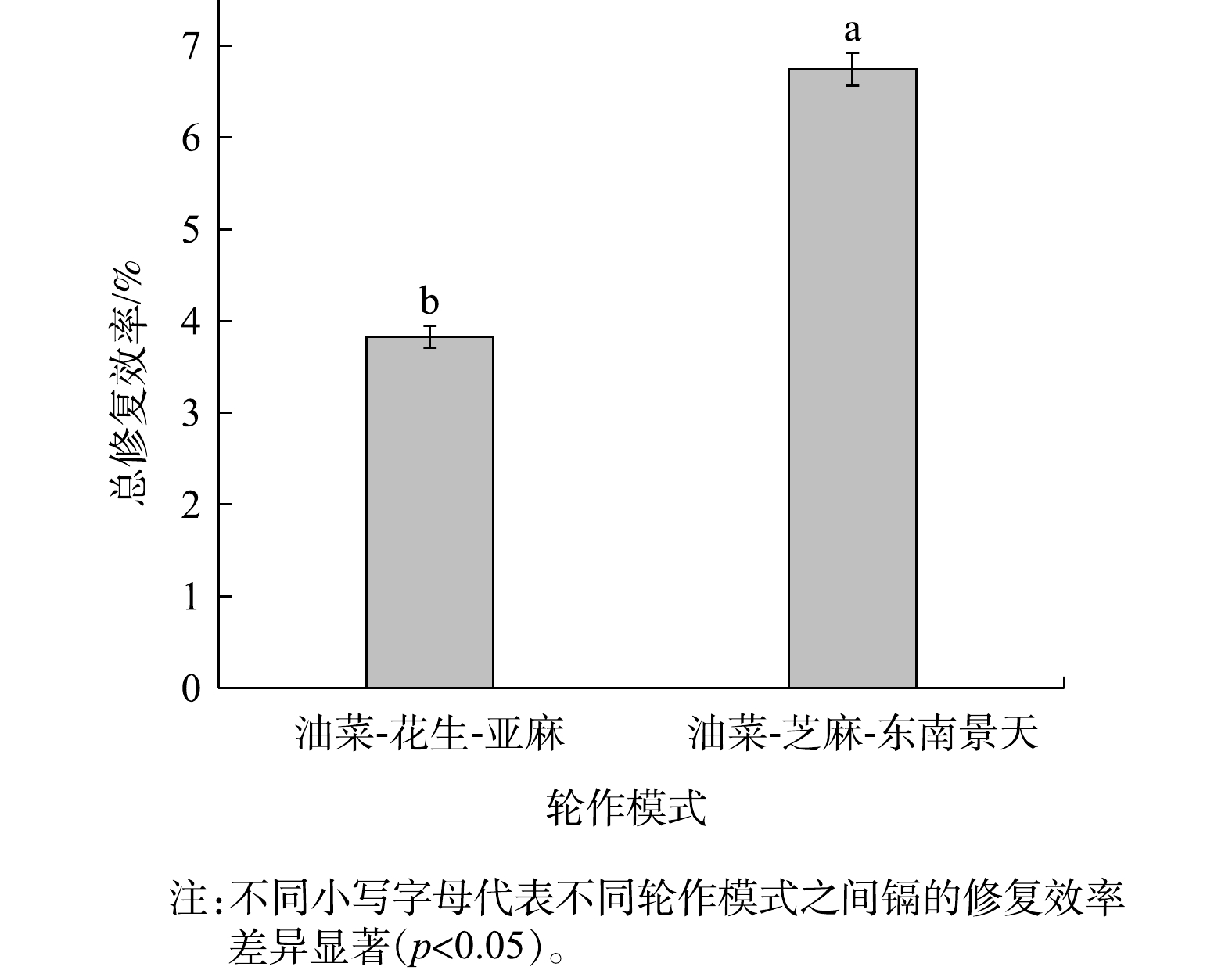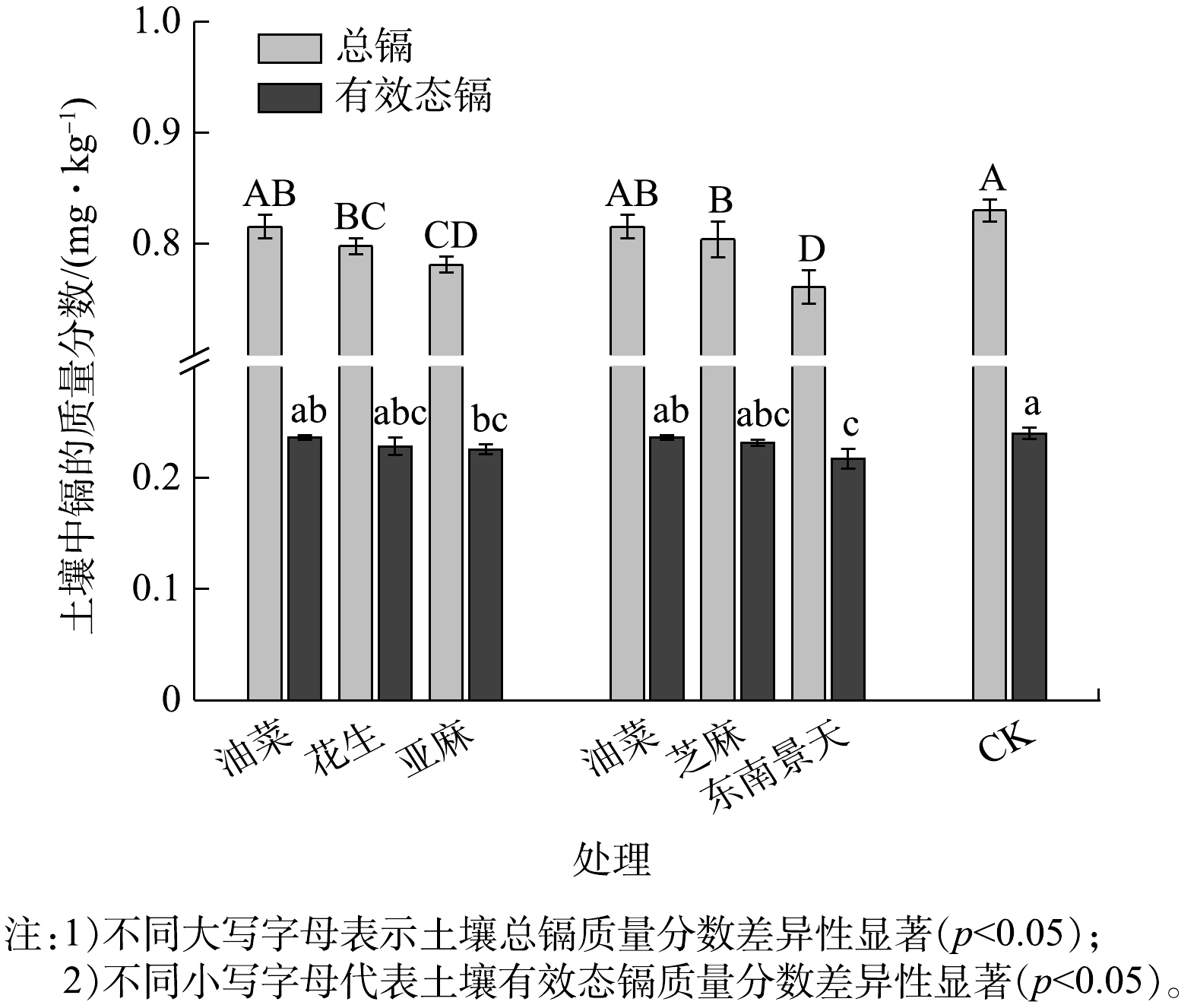-
由于采选矿、冶炼、化工生产等频繁工业活动,我国农田镉 (Cd) 污染问题严重[1-2]。调查显示,2000年至2019年,中国的农田土壤Cd质量分数增加了2倍,33.5%的农田土壤存在着不同程度的Cd污染[3]。土壤中Cd会被小麦、水稻等粮食作物吸收累积,通过食物链被人类食用后对人体皮肤、骨骼、神经系统和内脏器官造成不同程度的危害[4-6]。因此,有效解决农田Cd污染问题迫在眉睫。
针对Cd污染农田的治理,早期国内外学者主要侧重于使用原位固定技术,添加外源物质来降低土壤有效态Cd,使得粮食作物安全生产[5-7]。但随着大田环境的持续变化 (微生物活动、冻融循环、干湿交替等) ,土壤Cd容易被重新活化,长期修复效果难以保障,修复成本较高。相比之下,植物提取是一种通过种植作物,直接降低农田中总Cd质量分数的方法,具有绿色安全、经济环保等优点,已在重金属污染农田和场地中广泛应用[8]。如超积累植物龙葵与东南景天能在高Cd质量分数的土壤中正常生长,且其植物组织中Cd质量分数可超过100 mg·kg−1,富集系数 (BCF) 大于100、转运系数 (TF) 大于1,有很强的富集和转运能力[9-10]。然而,超累积植物普遍存在较强的地区适用性、回收处置工艺不成熟和收获后无法产生经济效益等缺陷[11-12]。为了实现大面积污染Cd农田的修复,用于植物修复的植物需要具有高生物量且生长迅速,能生产出部分用于补偿运营成本的经济产品[13],可食用植物组织中Cd的质量分数低于安全阈值,同时达到农田安全生产和污染修复的目标。近年来,湖南省响应农业供给侧结构性改革,种植结构逐渐调整,耕地轮作休耕,优先种植生物量高、吸收积累作用强的植物,治理Cd污染耕地[14-15]。
作物轮作是利用不同生长季节的植物,形成一年或多年的植物组合体系,能在时间、空间充分利用土地资源,避免作物重茬。轮作显著增加了单年内农作物的生物量,而且前茬作物根系分泌物对土壤Cd的活化作用可能会进一步提升后茬作物Cd的累积,提升单年内作物对土壤Cd的提取效率。涂鹏飞等[16]发现红叶甜菜-花生和油葵-花生轮作种植一季对土壤总Cd的提取量分别为53.34和40.80 g·ha−1,具有良好的修复潜力。GUO等[17]研究表明,油菜-玉米轮作能够安全有效的修复Cd、Pb污染,不仅具有成本较低的优点,而且秸秆菜籽粕中的重金属质量分数同时低于《有机肥料》 (NY525-2012) 与《饲料卫生标准》 (GB13078-2017) 中规定的限值。然而大部分作物轮作的研究仅集中在超富集植物与水稻的轮作,以及油料作物的轮作,很少有研究探究油料作物轮作和油料作物-超富集植物轮作的修复效率和经济效益的差异。此外,对作物进行3季或3季以上的长期轮作实验的研究还鲜有报道。
本研究建立了2种不同功能类型的轮作模式,分别为油料作物轮作、油料作物-超富集植物轮作。探究2种轮作模式生物量和Cd质量分数、Cd富集和转运能力、Cd累积量、油料作物提取粗油后油中Cd质量分数和修复效率以及修复前后土壤总Cd和有效态Cd的变化。以期筛选出修复效率最佳且经济效益较高的1种3季轮作模式,为Cd污染农田的边生产边修复提供参考。
-
本研究供试地点为湖南省浏阳市蕉溪镇常丰村 (28.18°75′77″N,113.08°08′50″E) 。实验前通过五点采样法均匀采集0~20.00 cm 深度的土样,去除大块杂物石块并风干,研磨过10目和100目筛后保存待测。供试土壤基本理化性质见表1,土壤Pb、Zn、Cu和Cd的背景值分别为46.13、178.56、30.12和0.83 mg·kg−1。油菜 (中油杂19) 购买自武汉中油种业科技有限公司,该品种适宜在长江流域冬油菜区秋播种植[18-20],花生 (福秀3号) 和芝麻 (航天油霸) 购买自浏阳淮川益星种业科技有限公司,这2个品种是浏阳当地大规模种植的品种,亚麻 (中亚油1号) 购买自中国农科院麻类研究所 (湖南长沙) ,适宜在湖南省种植,东南景天种苗由浙江大学提供。
-
本实验共设置2个处理和1个无植物种植对照 (CK) ,2个处理分别为油菜-花生-亚麻与油菜-芝麻-东南景天轮作。每个处理设置3次重复,共7个实验小区,各小区面积均为24.00 m2 (长×宽 = 20.00 m×1.20 m) ,各小区随机区组排列。每季作物种植前对土壤进行翻耕,施用三元复合肥 (N∶P2O5∶K2O=15∶15∶15) 750.00 kg·ha−1。作物种植密度与种植时间如表2所示。实验地水分管理、杂草管理和病虫害防治等农艺措施依照当地农业生产习惯进行。每季作物成熟后,使用5点取样法对各小区采集5株完整植株与其对应的根际土壤。
-
土壤样品的pH值使用pH测定方法 (PHS-3C,Leici,上海仪电科学仪器有限公司) 以m∶V=1∶2.5进行测量;土壤有机质 (OM) 采用Walkley-Black法测定,阳离子交换量 (CEC) 采用乙酸铵饱和法测定[8]。采用混合酸 (HCl-HNO3-HClO4) 法消解测定土壤总重金属质量分数[21],土壤有效态Cd的测定使用0.10 mol·L−1 CaCl2溶液 (m∶V= 1∶10) 提取[22]。将采集到的植物地上部分和地下部分,用自来水冲洗,再用去离子水清洗干净,滤干水分。将油菜、花生和芝麻分剪为根、茎、叶、籽粒和壳,亚麻分剪为根、茎、叶、籽粒、壳和纤维 (从茎中分离出) ,东南景天分剪为根 (地下部) 与茎 (地上部) ,再将各部位置于105 ℃下杀青1 h,75 ℃烘干至恒重后称重,用研磨机研磨成粉,植物粉末在HNO3-HClO4混合物中消解 (V∶V=85%∶5%) [23]。从干燥的植物籽粒中提取粗油采用索式法 (正己烷,m∶V=1∶10) [24-27],粗油在微波蒸发器 (RE-2000,上海亚荣生化仪器厂) 中用HNO3-H2O2混合溶液 (V∶V=2∶1) 消解后以测定油中Cd质量分数[8],土壤和植物样品在消解后使用ICP-OES (Optima8300,Perkinelmer,USA) 测定及原子吸收石墨炉 (GTA120,Varian,USA) 测定。植物和土壤样品的Cd回收率为93.45%~107.38%,分析过程中分别加入国家标准土壤样品 (GSS-4) 和植物样品 (GSV-1) 进行质量控制。
-
1) 富集系数如式 (1) 所示。
式中:
$ \mathrm{B}\mathrm{C}\mathrm{F}\mathrm{为}\mathrm{富}\mathrm{集}\mathrm{系}\mathrm{数};{\omega }_{2} $ 为植株Cd质量分数,mg·kg−1;$ {\omega }_{1} $ 为土壤Cd质量分数,mg·kg−1。2) 转运系数如式 (2) 所示。
式中:
$ TF $ 为转运系数;$ {\omega }_{3} $ 为植物地上部位的Cd质量分数,mg·kg−1;$ {\omega }_{4} $ 为植株地下部Cd质量分数,mg·kg−1。3) 植物生物量如式 (3) 所示。
式中:
$ {\mathrm{B}}_{1} $ 为植物生物量,kg·ha−1;$ {\mathrm{B}}_{2} $ 为单株生物量,g·株−1;$ {\mathrm{p}}_{1} $ 为种植密度,株·ha−1。4) 植物提取的Cd总量如式 (4) 所示。
式中:
$ {\mathrm{T}}_{1} $ 为植物提取的Cd总量,g·ha−1;$ {\mathrm{B}}_{3} $ 为植物地上部的生物量,kg·ha−1;$ {\mathrm{B}}_{4} $ 为植物地下部的生物量,kg·ha−1。5) 理论植物提取效率如式 (5) 和 (6) 所示。
式中:
$ \eta $ 为理论植物提取效率;$ m $ 为表层土的质量,g;$ s $ 为实验田面积,ha;$ h $ 为表层土的高度,取20.00 cm;$ {p}_{2} $ 为表层土的体积密度,取1.30 t·m−3[28]。 -
所有数据使用Excel 2019进行分析,并以平均值±标准差 (n=3) 表示。采用SPSS v23.0进行单因素方差分析,独立样本T检验和ANOVA中Duncan法分析各处理间数据差异性。使用OriginPro 2019进行数据可视化处理。
-
2种轮作模式中在Cd污染农田中轮作1年半后,各作物不同部位的生物量见表3。在油菜-花生-亚麻轮作模式中,3种作物的籽粒生物量分别为3.17、1.82和1.31 t·ha−1,其中油菜籽粒占其总生物量比重最大,为50.32%;亚麻籽粒占比最小,为20.79%。油菜-芝麻-东南景天轮作模式中,油菜的总生物量最高,为9.85 t·ha−1。其次为芝麻,总生物量为8.34 t·ha−1,其茎的占比最大为47.24%,根的占比最小为4.20%。东南景天的总生物量为3.18 t·ha−1。总体而言,种植3季以来,4种油料作物籽粒的生物量从大到小依次为油菜>花生>亚麻>芝麻,2种轮作模式的总生物量从大到小依次为:油菜-花生-亚麻 (31.05 t·ha−1) >油菜-芝麻-东南景天 (21.37 t·ha −1) 。
-
2种轮作模式各部位的Cd质量分数如表4所示。油菜-花生-亚麻的Cd质量分数为0.43~9.61 mg·kg−1,而油菜-芝麻-东南景天的Cd质量分数为0.41~42.17 mg·kg−1。东南景天地上部Cd质量分数为42.17 mg·kg−1,显著高于4种油料作物。花生在4种油料作物中,各部位Cd的质量分数最高。油料作物的茎和叶是Cd质量分数较高的部位,也是油料作物最主要的生物质,但其籽粒Cd质量分数均较低,除油菜外,油料作物籽粒Cd质量分数均超过0.50 mg·kg−1且低于1.00 mg·kg−1。冯刚等[29]研究表明,土壤中Cd向油菜籽粒运输过程中,根、茎、角果会对Cd产生过滤与阻隔作用,从而阻碍Cd向籽粒中的转移,这或许是油菜籽粒Cd质量分数低的原因。
如图1所示,使用正己烷从4种油料作物的籽粒中提取的粗油Cd质量分数在17.00~49.00 μg·kg−1范围内,其中,芝麻粗油的Cd质量分数最高,油菜粗油质量分数最低,分别为0.04和0.02 mg·kg−1,虽然《食品安全国家标准 植物油》 (GB 2716-2018) 未限定Cd质量分数,但本研究中粗油Cd质量分数均低于《土耳其可食用植物油标准》 (TS 12550) (<50.00 μg·kg−1) [24, 30-31]。这说明Cd未在4种油料作物的植物油中大量积累,在Cd污染农田中能生产安全的食用油。先前的研究也发现,油中的重金属质量分数远远低于籽粒中的重金属质量分数[24]。提油过程将籽粒分离为粗油和粕饼,由于粕饼含有大量蛋白质,是Cd2+的主要结合位点,而Cd2+不溶于油脂,因此未被粗油积累[32]。因此,粗油和Cd的化学特异性以及籽粒中蛋白质的丰富性是形成油中Cd质量分数低的主要原因。
另外,葛一陈等[33]研究表明,粕饼中的Cd可以通过酒石酸钾萃取进行脱毒处理,并且萃取剂对粕饼中营养元素质量分数影响不大,可实现粕饼的再利用,安全地作为动物饲料。目前,学者对富集作物残体的后处理已经做了不少研究,首先在将作物收集后,通过晾晒、干燥、切碎及压榨等方法实现快速减量处置[34-35]。其次学者们发现可以采取热解法实现富集作物残体的资源化利用,并回收利用重金属。ZHOU等[36]将油葵残体制备成生物炭后,通过调节溶液pH值至10.00,提取出生物炭中Pb、Zn和Cd,此时溶液中还有部分Ca、Mg、P、Cu和大量K,分离后可作为新的肥料来源。还有研究人员在密闭条件下,通过改变植物的某些特性,将作物残体热降解为木炭,这能产生具有经济价值的合成气和生物油,可以用做航空燃料[37-38]。
-
2种轮作中各作物不同部位的BCF如表5所示。相较于油料作物,东南景天Cd富集能力更强,地上部BCF达到59.77。先前的研究发现[39],东南景天的NRAMP家族基因拥有极强的Cd的积累转运能力,使其将大部分的Cd转运到叶肉细胞的液泡中去,随之植物体内的特异性转运蛋白SaHAM3会将Cd隔离在液泡中,从而缓解Cd对植物的毒性,少量存在于东南景天细胞质中的Cd,其体内会产生一些小分子有机化合物,如金属硫蛋白 (MT) ,这些小分子有机化合物会与Cd结合来降低其毒性。油菜、花生、亚麻、芝麻均为我国传统的油料作物,4种油料作物的非可食部位 (除油菜壳外) 的BCF均大于1,其中,花生是Cd富集能力最强的油料作物,而油菜富集能力最差,花生各部位Cd的BCF达到1.01~12.26,而油菜仅为0.52~1.91。以上结果说明,4种油料作物具有较好的Cd富集能力,而且油料作物在Cd胁迫下还具有缓解毒性的能力。有研究[40-41]表明,植物能将Cd储存在细胞液泡中,从而使液泡以外的细胞器及细胞质基质免受Cd的毒害,从而为植物解毒,减轻Cd对植物的伤害。
如表6所示,2种轮作中东南景天的TF根-茎 (9.63) 显著大于其他油料作物,这表明东南景天具有更强的将Cd从地下部转移至地上部的能力。更重要的是,2种轮作模式中油料作物的TF根-籽粒均小于0.5,其中花生的TF根-籽粒最低,为0.1,说明油料作物的Cd主要集中在根和非可食部位,Cd在油料作物籽粒中的迁移和累积受到抑制。从以上结果可以看出,4种油料作物可以作为植物修复的理想作物。
-
2种不同的轮作模式的Cd累积量见图2。6种作物提取的Cd累积量呈现东南景天>花生>亚麻>芝麻>油菜的趋势。东南景天的Cd累积量最高,达到118.77 g·ha−1,修复效率为5.51%,并且其地上部分的累积量显著高于地下部分。其次为花生,Cd累积量为52.94 g·ha−1,修复效率为2.46%。总体而言,油菜-花生-亚麻、油菜-芝麻-东南景天这2种轮作模式的Cd总累积量分别为82.56、145.20 g·ha−1。2种模式修复后,总理论植物提取Cd效率如图3所示,分别为3.83%、6.74%。曹雪莹[42]等研究发现,伴矿景天与Cd高积累晚稻品种陵两优229轮作,其Cd的积累量可达150.34 g·ha−1,本次实验中油菜-芝麻-东南景天模式的Cd总累积量与之差异不大,两种模式均有不错的Cd移除效果。
-
植物轮作前后土壤中总Cd质量分数和CaCl2-Cd质量分数如图4所示。实验前土壤Cd质量分数为0.83 mg·kg−1,植物轮作过程中土壤Cd质量分数有不同程度的降低,分别降至0.78和0.76 mg·kg−1。3季植物修复后,油菜-芝麻-东南景天模式土壤总Cd质量分数和CaCl2-Cd质量分数降低率更大,分别降低了8.29 %和9.53%;而花生-亚麻模式土壤总Cd质量分数和CaCl2-Cd质量分数降低率更少,分别降低了5.89和6.03%。经过计算,理想条件下2种轮作模式将本次实验农田Cd质量分数降至《土壤环境质量 农用地土壤污染风险管控标准 (试行) 》 (GB 15618-2018) 的二级标准 (≤0.30 mg·kg−1) 以下分别需要约15.90、11.36年的时间,所以相比之下,油菜-芝麻-东南景天模式能更好的缩短对农田Cd污染修复的时间,在中轻度Cd污染土壤中在不影响植物健康的情况下能有效降低土壤Cd污染。
-
农田是广大农民的主要经济收入来源,如表7所示,我们根据本实验的运营成本和实际收益,计算出油菜-花生-亚麻这种轮作模式每公顷可以产生2.90×104 元的净收益。但是由于东南景天的种苗费用和种植成本较大,油菜-芝麻-东南景天模式抵除油料作物的净收益后,每公顷仍需要投入18.90×104 元。但本研究对作物经济效益评价中,仅考虑了作物的籽粒的产值,而没有考虑秸秆回收后生成的能源的潜在经济效益以及东南景天后续的开发潜力。我们以Cd累积量、粗油中Cd质量分数、修复效率、经济效益和安全生产等指标综合对比2种不同轮作模式对农田Cd污染的应用潜力,结果表明油菜-芝麻-东南景天模式有更好的Cd修复效果,而油菜-花生-亚麻模式虽修复效率较低,但是能产生较好的经济效益。另外,在对Cd污染采用植物提取修复时,会出现植物对土壤中Cd的修复效率会随修复年限的增加而降低的现象,而本研究仅仅考虑了在理想条件下的年均Cd移除效率,后期应加强修复年限对于移除效率的影响,进一步深入研究。
-
1) 实验对比了2种轮作模式的应用潜力,为安全利用Cd污染农田提供了一定的参考。2种轮作模式的农作物在中度Cd污染农田均能正常生长,6种植物总生物量呈现亚麻>油菜>花生>芝麻>东南景天的趋势,油菜-花生-亚麻模式的总生物量显著大于油菜-芝麻-东南景天模式。
2) 油料作物非可食部位Cd的BCF均大于1,壳和籽粒Cd的BCF小于1,4种油料作物籽粒提取的粗油Cd质量分数均未超出国际食用油标准。
3) 2种轮作模式中油菜-芝麻-东南景天模式的Cd累积量更大、修复效率更高,但是需要投入大量资金,油菜-花生-亚麻模式修复效率略低,但能产生良好的经济效益。
三季油料作物轮作模式安全利用镉污染农田及其经济效益评估
Safe utilization of cadmium-contaminated agricultural land and evaluation of its economic benefits under three-season oil crop rotation patterns
-
摘要: 我国农田镉 (Cd) 污染严重且普遍,安全利用和修复Cd污染农田意义重大。在中度Cd污染农田中建立了2种3季轮作模式,探究不同轮作模式对土壤Cd的长期修复效应和安全生产的可行性。结果表明:油菜-花生-亚麻和油菜-芝麻-东南景天轮作模式的农作物均在中度Cd污染农田生长正常。东南景天的地上部的Cd质量分数可达42.17 mg·kg−1,富集系数 (BCF) 为59.77。油料作物非可食部位Cd的BCF均大于1,壳和籽粒Cd的BCF小于1。4种油料作物籽粒提取的粗油Cd质量分数为17.00~49.00 μg·kg−1。2种轮作模式的Cd累积量与理论修复效率均有显著差异 (p<0.05) ,Cd累积量分别为82.56、145.20 g·ha−1,理论修复Cd效率分别为3.83%、6.74%。2种轮作模式修复后土壤总Cd与CaCl2-Cd质量分数显著降低 (p<0.05) ,其中油菜-芝麻-东南景天轮作模式中总Cd质量分数由0.83 mg·kg−1降至0.76 mg·kg−1,CaCl2-Cd质量分数由0.24 mg·kg−1降至0.22 mg·kg−1。油菜-花生-亚麻模式产生的经济效益为2.90×104 元·ha−1,而油菜-芝麻-东南景天模式则需投入为1.90×105元·ha−1。2种轮作模式都能起到安全利用的效果,其中油菜-芝麻-东南景天这种轮作模式有更好的Cd污染修复效果,而油菜-花生-亚麻轮作模式能产生更好的经济效益。本实验研究结果可为安全利用Cd污染农田提供参考。Abstract: China has serious and extensive pollution of cadmium (Cd) in agricultural land, and the safe utilization and remediation of Cd-contaminated agricultural land holds significant importance. Two 3-season crop rotation patterns were established in moderately Cd-contaminated agricultural land to investigate the long-term remediation effect of different crop rotation patterns on soil Cd and the feasibility of safe production. The results showed that crops in both the Rape-Peanut-Flax and Rape-Sesame-Sedum alfredii rotation patterns grew normally on moderately Cd-contaminated farmland. The Cd concentration of aboveground of Sedum alfredii was 42.17 mg·kg−1 and the Bioconcentration factor (BCF) was 59.77. The BCF of Cd in non-edible parts of oilseed crops were all greater than 1, while the BCF of shell and seed Cd were less than 1. The Cd concentration of crude oil extracted from the seeds of the four oilseed crops was 17.00~49.00 μg·kg−1. The Cd accumulation and theoretical restoration efficiency of the two crop concentration rotation patterns were significantly different (p<0.05), with Cd accumulation of 82.56 and 145.20 g·ha−1 and theoretical restoration Cd efficiency of 3.83% and 6.74%, respectively. The total Cd and CaCl2-Cd concentrations of the soil were significantly decreased (p < 0.05) after the remediation of the two rotation patterns. The total Cd concentration decreased from 0.83 mg·kg −1 to 0.76 mg·kg−1 and CaCl2-Cd concentration decreased from 0.24 mg·kg−1 to 0.22 mg·kg−1, respectively, in the Rape-Sesame-Sedum alfredii rotation. The economic efficiency of Rape-Peanut-Flax rotation was 2.90×104 yuan·ha−1, while the economic efficiency of Rape-Sesame-Sedum alfredii rotation was −1.89×10 5 yuan·ha−1. The two crop rotation patterns were able to safely utilize Cd-contaminated agricultural land, and the Rape-Sesame-Sedum alfredii rotation had better restoration effects, while the Rape-Peanut-Flax rotation could produce higher economic benefits. The results of this experiment can provide reference for the safe utilization of Cd contaminated agricultural land.
-
Key words:
- crop rotation /
- phytoremediation /
- cadmium /
- sedum alfredii /
- crude vegetable oil /
- safe utilization
-

-
表 1 供试土壤的基本理化性质
Table 1. Basic physicochemical properties of tested soil
pH CEC/(cmol·kg-1) OM/(g·kg-1) Cd/(mg·kg-1) CaCl2-Cd/
(mg·kg-1)5.24±0.02 15.58±0.02 49.83±0.03 0.83±0.02 0.24±0.01 表 2 作物的种植密度与种植时间
Table 2. Planting density and planting time of crops
轮作模式 轮作顺序 作物品种 种植密度/ (株·ha−1) 种植时间 收获时间 油菜-花生-亚麻 第1季 油菜 1.5×105 2020年10月下旬 2021年5月上旬 第2季 花生 6.7×104 2021年5月中旬 2021年10月上旬 第3季 亚麻 1.2×106 2021年11月上旬 2022年5月上旬 油菜-芝麻-东南景天 第1季 油菜 1.5×105 2020年10月下旬 2021年5月上旬 第2季 芝麻 1.1×105 2021年5月下旬 2021年9月中旬 第3季 东南景天 3.3×105 2021年10月下旬 2022年5月下旬 表 3 轮作模式中各作物不同部位的生物量
Table 3. Biomass of different parts of each crop in rotation pattern
t·ha−1 部位 油菜-花生-亚麻 油菜-芝麻-东南景天 油菜 花生 亚麻 油菜 芝麻 东南景天 根 1.00±0.07Bd 0.38±0.02Cd 2.67±0.24Ab 0.99±0.06Bd 0.35±0.03Cd 0.42±0.05Cb 茎 2.17±0.20Cb 2.80±0.19Ba 3.67±0.15Aa 2.18±0.20Cb 3.94±0.27Aa 2.76±0.41Ba 叶 1.44±0.13Bc 2.42±0.24Aab 2.35±0.21Ac 1.455±0.13Bc 1.55±0.12Bb — 籽粒 3.17±0.38Aa 1.82±0.14Bbc 1.31±0.09Cd 3.11±0.17Aa 0.79±0.09Dc — 壳 2.11±0.15Ab 1.26±2.77Cc 1.38±0.12Cd 2.12±0.11Ab 1.70±0.10Bb — 纤维 — — 1.11±0.15d — — — 总生物量
9.89±0.70B
8.68±0.31C 12.48±0.55A 9.85±0.37B 8.34±0.14C 3.18±0.37D 注:1) 不同的大写字母表示不同作物同一部位生物量差异性显著 (p<0.05) ;2) 不同的小写字母代表相同作物不同部位的生物量差异性显著 (p<0.05) 。 表 4 2种轮作中各种作物不同部位的Cd质量分数
Table 4. Cd concentration in different parts of different crops in two rotations
mg·kg−1 部位 油菜-花生-亚麻 油菜-芝麻-东南景天 油菜 花生 亚麻 油菜 芝麻 东南景天 根 1.10±0.18Db 7.82±0.32Ac 2.23±0.26Cb 1.11±0.07Db 4.20±0.36Ba 4.57±1.03Bb 茎 0.94±0.10Eb 8.54±0.26Bb 1.36±0.16Dc 0.94±0.05Ec 2.79±0.16Cb 42.17±1.93Aa 叶 1.56±0.29Da 9.61±0.11Aa 2.80±0.23Ba 1.60±0.14Da 1.95±0.18Cc — 籽粒 0.48±0.02Cc 0.81±0.10Bd 0.92±0.09Ad 0.46±0.03Cd 0.98±0.02Ad — 壳 0.43±0.01Cc 1.05±0.01Bd 0.59±0.02Cd 0.41±0.03Cd 1.33±0.38Ad — 纤维 — — 2.93±0.33a — — — 注:1) 不同的大写字母表示不同作物同一部位的Cd质量分数差异性显著 (p<0.05) ;2) 不同的小写字母代表同一作物不同部位的Cd质量分数差异性显著 (p<0.05) 。 表 5 2种轮作中各种作物不同部位的富集系数
Table 5. Enrichment factor of different crop parts in the two rotations
部位 油菜-花生-亚麻 油菜-芝麻-东南景天 油菜 花生 亚麻 油菜 芝麻 东南景天 根 1.33±0.11Eb 9.98±0.59Ac 2.87±0.33Db 1.36±0.09Eb 5.29±0.5Ca 6.79±0.59Bb 茎 1.15±0.12Db 10.89±0.45Bb 1.75±0.23Dc 1.17±0.05Dc 3.51±0.14Cb 59.77±3.43Aa 叶 1.91±0.33Da 12.26±0.13Aa 3.59±0.26Ba 1.96±0.18DEa 2.45±0.26CDc — 籽粒 0.58±0.02Cc 1.01±0.14Bd 1.19±0.09Ad 0.56±0.03Cd 1.25±0.02Ad — 壳 0.52±0.04Cc 1.33±0.03Bd 0.76±0.02Cd 0.50±0.03Cd 1.68±0.50Ad — 纤维 — — 3.77±0.37a — — — 注:1) 不同大写字母表示不同作物同一部位数据差异性显著 (p<0.05) ;2) 不同小写字母代表同一作物不同部位数据差异性显著 (p<0.05) 。 表 6 2种轮作中各种作物不同部位的转运系数
Table 6. Transport factor of different parts of various crops in the two rotations
部位 油菜-花生-亚麻 油菜-芝麻-东南景天 油菜 花生 亚麻 油菜 芝麻 东南景天 根-茎 0.87±0.15Bb 1.09±0.05Bb 0.62±0.13Bb 0.85±0.08Bb 0.67±0.06Ba 9.63±0.58A 根-叶 1.43±0.13ACa 1.23±0.07Ba 1.27±0.21Ba 1.44±0.06ACa 0.46±0.01Cb — 根-籽粒 0.44±0.02Ac 0.10±0.01Cc 0.42±0.06Abc 0.41±0.03Ac 0.23±0.02Bb — 根-壳 0.39±0.04Ac 0.13±0.01Cc 0.27±0.02Bc 0.37±0.02Ac 0.32±0.11ABb — 根-纤维 — — 1.32±0.17a — — — 注:1) 不同大写字母表示不同作物同一部位数据差异性显著 (p<0.05) ;2) 不同小写字母代表同一作物不同部位数据差异性显著 (p<0.05) 。 表 7 2种轮作模式经济效益的估算
Table 7. Estimation of economic benefits of two crop rotation modes
轮作
模式作物 收入 成本 利润 籽粒产量/
(t·ha−1)价格/
(w·t−1)总收入/
(w·ha−1)种子/
(w·ha−1)农药/
(w·ha−1)肥料/
(w·ha−1)整地/
(w·ha−1)播种/
(w·ha−1)收获/
(w·ha−1)其他用工/
(w·ha−1)合计成本/
(w·ha−1)净利润/
(w·ha−1)总利润/
(w·ha−1)油菜-
花生-
亚麻油菜 3.17 0.70 2.20 0.03 0.03 0.17 0.11 0.03 0.15 0.23 0.75 1.45 2.90 花生 1.82 1.00 1.82 0.24 0.03 0.17 0.11 0.12 0.18 0.45 1.30 0.52 亚麻 1.31 1.40 1.83 0.11 0.03 0.18 0.11 0.08 0.16 0.23 0.90 0.93 油菜-
芝麻-东
南景天油菜 3.17 0.70 2.20 0.03 0.03 0.17 0.11 0.03 0.15 0.23 0.75 1.45 −18.90 芝麻 0.79 1.60 1.26 0.03 0.03 0.17 0.11 0.04 0.15 0.45 0.98 0.28 东南景天 — — — 19.80 0.03 0.20 0.11 0.06 0.20 0.23 20.63 −20.63 -
[1] SUN Y, ZHOU Q, XU Y, et al. Phytoremediation for co-contaminated soils of benzo [a] pyrene (B [a] P) and heavy metals using ornamental plant Tagetes patula[J]. Journal of Hazardous Materials, 2011, 186(2/3): 2075-2082. [2] ZHANG Z, RENGEL Z, CHANG H, et al. Phytoremediation potential of Juncus subsecundus in soils contaminated with cadmium and polynuclear aromatic hydrocarbons (PAHs)[J]. Geoderma, 2012, 175: 1-8. [3] YUAN X, XUE N, HAN Z. A meta-analysis of heavy metals pollution in farmland and urban soils in China over the past 20 years[J]. Journal of Environmental Sciences, 2021, 101: 217-226. doi: 10.1016/j.jes.2020.08.013 [4] YANG W, WANG S, ZHOU H, et al. Combined amendment reduces soil Cd availability and rice Cd accumulation in three consecutive rice planting seasons[J]. Journal of Environmental Sciences, 2022, 111: 141-152. doi: 10.1016/j.jes.2021.03.027 [5] IRSHAD M K, CHEN C, NOMAN A, et al. Goethite-modified biochar restricts the mobility and transfer of cadmium in soil-rice system[J]. Chemosphere, 2020, 242: 125152. doi: 10.1016/j.chemosphere.2019.125152 [6] TANG B, XU H, SONG F, et al. Effect of biochar on immobilization remediation of Cd- contaminated soil and environmental quality[J]. Environmental Research, 2022, 204: 111840. doi: 10.1016/j.envres.2021.111840 [7] 曾海岑, 杨启豪, 潘素, 等. 钝化材料应用于稻田土壤镉污染治理的研究进展[J]. 中国资源综合利用, 2022, 40(8): 111-114. doi: 10.3969/j.issn.1008-9500.2022.08.032 [8] YANG Y, ZHOU X, TIE B, et al. Comparison of three types of oil crop rotation systems for effective use and remediation of heavy metal contaminated agricultural soil[J]. Chemosphere, 2017, 188: 148-156. doi: 10.1016/j.chemosphere.2017.08.140 [9] DU S, LU Q, LIU L, et al. Rhodococcus qingshengii facilitates the phytoextraction of Zn, Cd, Ni, and Pb from soils by Sedum alfredii Hance[J]. Journal of Hazardous Materials, 2022, 424: 127638. doi: 10.1016/j.jhazmat.2021.127638 [10] HAN R, DAI H, ZHAN J, et al. Clean extracts from accumulator efficiently improved Solanum nigrum L. accumulating Cd and Pb in soil[J]. Journal of Cleaner Production, 2019, 239: 118055. doi: 10.1016/j.jclepro.2019.118055 [11] 李旭, 晁赢, 阎祥慧, 等. 植物修复技术治理农田土壤重金属污染的研究进展[J]. 河南农业科学, 2022, 51(12): 10-18. doi: 10.15933/j.cnki.1004-3268.2022.12.002 [12] 李吉锋. 超累积植物修复矿区土壤重金属污染研究进展[J]. 矿产保护与利用, 2020, 40(5): 138-143. [13] YANG W J, GU J F, ZHOU H, et al. Effect of three Napier grass varieties on phytoextraction of Cd-and Zn-contaminated cultivated soil under mowing and their safe utilization[J]. Environmental Science and Pollution Research, 2020, 27(14): 16134-16144. doi: 10.1007/s11356-020-07887-1 [14] 丁国才, 段再燕, 王定石, 等. 试论耕地轮作休耕对农业持续性发展的意义[J]. 农业开发与装备, 2022(5): 88-90. [15] 李铁球, 戴力, 夏胜平, 等. 湖南省稻区种植结构调整研究Ⅲ——水稻改旱作[J]. 湖南农业科学, 2019(7): 105-109. [16] 涂鹏飞, 谭可夫, 陈璘涵, 等. 红叶甜菜-花生和油葵-花生轮作修复土壤Cd的能力[J]. 农业资源与环境学报, 2020, 37(4): 609-614. [17] GUO J, ZHENG G, YANG J, et al. Safe utilization of cadmium-and lead-contaminated farmland by cultivating a winter rapeseed/maize rotation compared with two phytoextraction approaches[J]. Journal of Environmental Management, 2022, 304: 114306. doi: 10.1016/j.jenvman.2021.114306 [18] 王新发, 王汉中, 等. 高油高产优质多抗油菜新品种中油杂19的选育与应用[J]. 中国科技成果, 2022, 23(15): 1. [19] 卞仕晶, 王华, 刘礼明. 油菜品种中油杂19的特征特性及高产优质栽培技术[J]. 现代农业科技, 2018, 730(20): 16-18. [20] 肖小军, 肖国滨, 郑伟, 等. 播期与密度对油蔬两用型油菜中油杂19产量的影响[J]. 土壤与作物, 2023, 12(1): 44-52. [21] PAGE K, HARBOTTLE M, CLEALL P, et al. Heavy metal leaching and environmental risk from the use of compost-like output as an energy crop growth substrate[J]. Science of the Total Environment, 2014, 487: 260-271. doi: 10.1016/j.scitotenv.2014.04.021 [22] PUEYO M, LóPEZ-SáNCHEZ J, RAURET G. Assessment of CaCl2, NaNO3 and NH4NO3 extraction procedures for the study of Cd, Cu, Pb and Zn extractability in contaminated soils[J]. Analytica Chimica Acta, 2004, 504(2): 217-226. doi: 10.1016/j.aca.2003.10.047 [23] ZHAO F, MCGRATH S, CROSLAND A. Comparison of three wet digestion methods for the determination of plant sulphur by inductively coupled plasma atomic emission spectroscopy (ICP‐AES)[J]. Communications in Soil Science and Plant Analysis, 1994, 25(3-4): 407-418. doi: 10.1080/00103629409369047 [24] YANG Y, LI H, PENG L, et al. Assessment of Pb and Cd in seed oils and meals and methodology of their extraction[J]. Food Chemistry, 2016, 197: 482-488. doi: 10.1016/j.foodchem.2015.10.143 [25] DE MENEZES M L, JOHANN G, DIóRIO A, et al. Phenomenological determination of mass transfer parameters of oil extraction from grape biomass waste[J]. Journal of Cleaner Production, 2018, 176: 130-139. doi: 10.1016/j.jclepro.2017.12.128 [26] CHENG W Y, AKANDA J M H, NYAM K L. Kenaf seed oil: A potential new source of edible oil[J]. Trends in Food Science & Technology, 2016, 52: 57-65. [27] SUBRAMANIAN R, SUBBRAMANIYAN P, AMEEN J N, et al. Double bypasses soxhlet apparatus for extraction of piperine from Piper nigrum[J]. Arabian Journal of Chemistry, 2016, 9: 537-540. doi: 10.1016/j.arabjc.2014.02.013 [28] ZHANG X, XIA H, LI Z, et al. Potential of four forage grasses in remediation of Cd and Zn contaminated soils[J]. Bioresource Technology, 2010, 101(6): 2063-2066. doi: 10.1016/j.biortech.2009.11.065 [29] 冯刚, 王鑫, 白九元, 等. 油菜对Cd污染土壤的修复潜力分析[J]. 四川大学学报(自然科学版), 2018, 55(1): 172-178. [30] LLORENT-MARTíNEZ E, ORTEGA-BARRALES P, FERNáNDEZ-DE CóRDOVA M, et al. Investigation by ICP-MS of trace element levels in vegetable edible oils produced in Spain[J]. Food Chemistry, 2011, 127(3): 1257-1262. doi: 10.1016/j.foodchem.2011.01.064 [31] MENDIL D, ULUöZLü Ö D, TUEZEN M, et al. Investigation of the levels of some element in edible oil samples produced in Turkey by atomic absorption spectrometry[J]. Journal of Hazardous Materials, 2009, 165(1-3): 724-728. doi: 10.1016/j.jhazmat.2008.10.046 [32] LEI B, LI-CHAN E C, OOMAH B D, et al. Distribution of cadmium-binding components in flax (Linum usitatissimum L. ) seed[J]. Journal of Agricultural and Food Chemistry, 2003, 51(3): 814-821. doi: 10.1021/jf0209084 [33] 葛一陈, 杨洋, 黎红亮, 等. 不同萃取剂对花生粕饼中重金属的去除效果[J]. 环境工程技术学报, 2020, 10(1): 112-117. doi: 10.12153/j.issn.1674-991X.20190053 [34] 王鹏程, 胡鹏杰, 钟道旭, 等. 镉锌超积累植物伴矿景天产后鲜样快速处置技术[J]. 环境工程学报, 2017, 11(9): 5307-5312. [35] 张秋野, 胡鹏杰, 王鹏程, 等. 伴矿景天汁液中重金属形态及絮凝沉淀效果优化[J]. 环境工程学报, 2018, 12(2): 611-617. [36] ZHOU J, CHEN L, PENG L, et al. Phytoremediation of heavy metals under an oil crop rotation and treatment of biochar from contaminated biomass for safe use[J]. Chemosphere, 2020, 247: 125856. doi: 10.1016/j.chemosphere.2020.125856 [37] CAO X, MA L, SHIRALIPOUR A, et al. Biomass reduction and arsenic transformation during composting of arsenic-rich hyperaccumulator Pteris vittata L[J]. Environmental Science and Pollution Research, 2010, 17: 586-594. doi: 10.1007/s11356-009-0204-7 [38] GHOSH M, SINGH S. A review on phytoremediation of heavy metals and utilization of it’s by products[J]. Asian J Energy Environ, 2005, 6(4): 18. [39] 张杰. 超积累植物东南景天Cd耐性和积累的分子机制[D]. 杭州, 浙江大学, 2015 [40] CHARDONNENS A N, TEN BOOKUM W M, KUIJPER L D, et al. Distribution of cadmium in leaves of cadmium tolerant and sensitive ecotypes of Silene vulgaris[J]. Physiologia Plantarum, 1998, 104(1): 75-80. doi: 10.1034/j.1399-3054.1998.1040110.x [41] 史新杰, 李卓, 庄文化, 等. 油菜对土壤重金属Cd抗性的研究进展[J]. 中国农学通报, 2017, 33(14): 81-86. [42] 曹雪莹, 谭长银, 蔡润众, 等. 植物轮作模式对镉污染农田的修复潜力[J]. 农业环境科学学报, 2022, 41(4): 765-773. -




 下载:
下载:




















